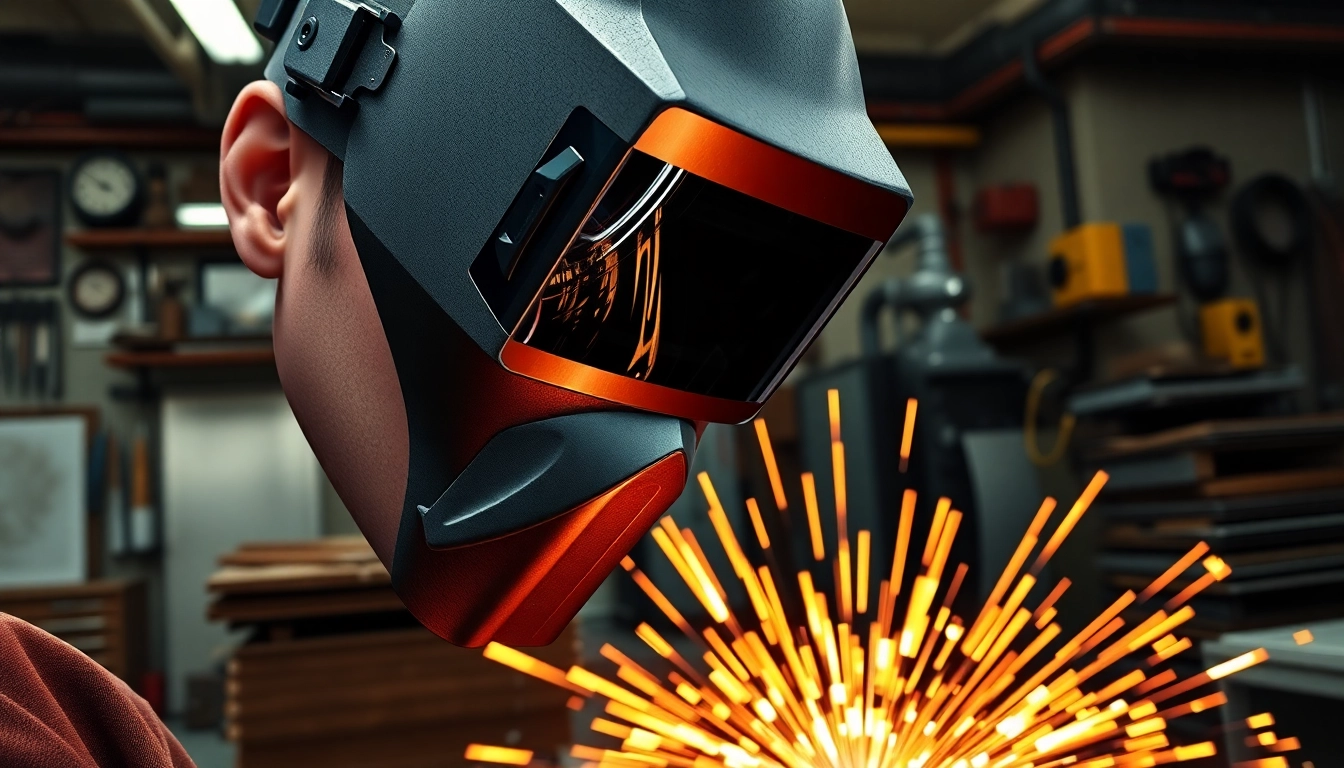Understanding Welding Masks
Welding is a rewarding but hazardous profession, and personal protective equipment (PPE) plays a crucial role in ensuring the safety of welders. One of the most vital components of welding safety gear is the welding mask, designed to protect the welder’s face, eyes, and neck from the extreme conditions associated with the process. In this article, we will explore the intricacies of welding masks, the importance of safety in welding, how to choose the right mask for your needs, and emerging trends in this essential piece of equipment.
What is a Welding Mask?
A welding mask, also known as a welding helmet, is a protective headgear worn by welders to shield their face and eyes from harmful radiation, intense heat, sparks, and molten metal. The primary function of welding masks is to provide a barrier against the UV and infrared (IR) radiation emitted during the welding process, which can lead to severe eye injuries known as “welders’ flash” or photokeratitis. Welding masks are engineered to reduce glare and brightness while offering adequate visibility of the workpiece.
Types of Welding Masks Available
There are several types of welding masks available in the market, each designed for different welding applications and user preferences. The most common types include:
- Auto-Darkening Welding Helmets: These helmets use sensors that automatically adjust the lens shade based on the brightness of the welding arc, providing optimum visibility while protecting the welder’s eyes.
- Passive Welding Helmets: Equipped with a fixed lens, these helmets require the user to lift the mask before striking an arc. They are generally less expensive but offer less convenience.
- Digital Welding Helmets: Featuring advanced optics and customizable settings, these helmets may include features such as grind mode and adjustable sensitivity settings.
- Pancake Welding Hoods: Lightweight and offering a high level of comfort, pancake hoods are designed for specific welding applications and provide excellent head protection.
Key Features of Quality Welding Masks
When investing in a welding mask, several key features should be considered to ensure optimal performance and safety:
- Lens Quality: The lens should provide clear visibility without distortion. Look for models that offer a high optical clarity rating.
- Shade Adjustment: Auto-darkening masks should have a wide range of shade levels to accommodate different welding processes.
- Comfort: Weight, headgear adjustability, and padding can all contribute to prolonged use without discomfort.
- Durability: The mask should be constructed from durable materials that can withstand the rigors of welding.
Importance of Safety in Welding
Welding can be a dangerous endeavor if the proper safety precautions are not taken. Various hazards can impact welders, which is why investing in safety gear such as welding masks is essential.
Why You Need a Welding Mask
The necessity of wearing a welding mask cannot be overstated. Beyond shielding the eyes from UV and IR radiation, masks prevent inhalation of harmful fumes and protect the skin against sparks and spatter. Moreover, they significantly reduce the risk of serious injuries, which might even lead to temporary or permanent blindness without adequate protection.
Common Hazards Faced Without Proper Protection
Welders face a variety of risks, including:
- Eye Injuries: Exposure to harmful light can cause vision loss or injury.
- Respiratory Issues: Inhaling toxic fumes and gases can lead to long-term health complications.
- Burns: Sparks and hot metal can cause painful skin burns if proper protection is not worn.
Comparing Safety Ratings of Welding Masks
Welding masks are subject to safety standards that indicate their effectiveness. The American National Standards Institute (ANSI), for example, sets regulations that masks must meet to ensure they adequately protect the wearer. These ratings cover various aspects, including lens quality, shade range, and overall construction. A mask that meets high ANSI standards is generally a reliable choice for professionals in the welding industry.
Choosing the Right Welding Mask for Your Needs
With the multitude of options available, selecting the appropriate welding mask can be overwhelming. Here are some guidelines to help you make an informed decision.
Evaluating Your Welding Environment
Your welding environment will significantly influence the type of mask you require. Factors to consider include:
- Type of Welding: Different welding processes (TIG, MIG, Stick) may demand specific mask features.
- Work Conditions: If you are working in low-light conditions or areas with fine particles, you may need additional features such as a grind mode or a wider field of view.
- Duration of Use: For extended use, opt for masks with superior comfort features.
Auto-Darkening vs. Traditional Masks
Choosing between auto-darkening and traditional masks largely depends on personal preference and work requirements. Auto-darkening masks enhance comfort and convenience, allowing for easier visibility adjustments without manual intervention, while traditional masks might be favored for their simplicity and cost-effectiveness. Assessing your welding habits can help you determine which type is the best fit for your work environment.
Budget Considerations for Welding Masks
Quality welding masks come with varying price tags. While it is tempting to choose the cheapest option available, it is crucial to invest in a mask that offers high protection and durability. Quality should not be compromised for cost; make sure to evaluate the features and safety ratings based on your budget and welding needs.
Maintenance and Care for Welding Masks
Proper maintenance is essential to ensure the longevity and optimal performance of your welding mask.
Cleaning Techniques for Longevity
Keeping your welding mask clean is crucial to maintaining visibility and performance. Here are some practical cleaning tips:
- Regular Inspection: Routinely check for cracks or damage and clean lenses after each use to remove soot and spatter.
- Use Non-Abrasive Materials: Clean the lens with soft cloths or specific cleaning wipes to avoid scratches.
- Follow Manufacturer’s Instructions: Always adhere to the care guidelines provided by the manufacturer.
Storage Tips to Protect Your Equipment
Storing your welding mask correctly can prevent unnecessary wear and tear:
- Keep in a Protective Bag: Use a designated bag or case to avoid scratches and damage.
- Avoid Extreme Temperatures: Store in a place where extreme temperature fluctuations are minimized.
- Ensure Lenses are Covered: Protect the lenses from exposure when not in use.
Signs Your Welding Mask Needs Replacement
If you notice any of the following signs, it may be time to consider replacing your welding mask:
- Scratched or Cloudy Lenses: Impaired visibility can hinder your work and increase the risk of accidents.
- Damaged Headgear: If the headgear is broken or does not fit properly, it may jeopardize your safety.
- Burnt or Melting Parts: Exposure to sparks and heat can compromise the protection of your mask.
Future Trends in Welding Mask Technology
The welding industry is evolving rapidly, particularly in terms of technology and safety features in masks.
Innovations to Look For in Welding Masks
As the demand for enhanced safety and efficiency grows, welding mask manufacturers are adopting innovative technologies, such as:
- Smart Sensors: Future welding masks may include smart sensors that adjust to ambient light changes automatically.
- Enhanced Communication Features: Masks may include built-in communication systems for better interaction between team members.
- Contactless Controls: Touchless controls may enable users to toggle settings without removing their gloves or masks.
How Technology Can Enhance Safety
Technological advancements enhance not only the functionality of welding masks but also user safety. Features such as automatic filtering for harmful particulates and integration with health monitoring devices can provide welders with essential data to protect against exposure to hazardous conditions.
Consumer Preferences and Market Shifts
As data analytics become a more significant part of consumer behavior, manufacturers are taking note of user preferences when developing new welding masks. People are increasingly seeking aspects such as comfort, ease of use, customizable settings, and durability, leading to a broader range of options that cater to individual needs.



